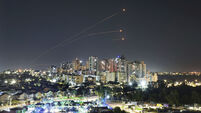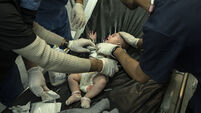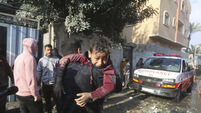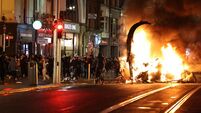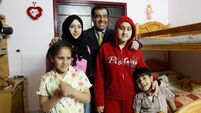Elaine Loughlin: Children with the wounds of war are everywhere

A baby wounded in Israeli bombardment of the Gaza Strip is treated in a hospital in Khan Younis. Hospitals in Gaza are completely overwhelmed. Picture: AP Photo/Fatima Shbair
Omar, a “sweet little boy with gentle, gentle eyes” is nine years old.
But he keeps those eyes closed for long periods now, willing the images of his mother, father, and twin brother to come into sharp focus in his mind.
Omar is terrified, not that he too will die in an Israeli airstrike, but that the faces of his lost loved ones will fade.
Shima had just started speaking again, but as daylight broke so too did the fragile ceasefire and deep trauma once more has left her mute.
In Ireland, children of her age are in second class, it’s an exciting time getting ready to put on nativity plays and writing letters to Santa. But for this little girl, who has already lost her right leg and right arm in a blast, staying alive is uncertain.
She lies in the overcrowded Nasser Hospital, which before the resumption of war on Friday morning, was running at 200% capacity. She listens to the bombs rain down, she feels the impact of each repeated strike and she waits as others decide her fate and the fate of more than a million other children in Gaza.
Hundreds of women and children sleep in waiting rooms and along the corridors of the hospital in Khan Younis. Children with the wounds of war are everywhere.
Within hours of the ceasefire ending seven short days of reprieve, Israeli missiles had killed more than 35 people, that number multiplied as the day wore on.
During the pause, James Elder, global spokesman with Unicef, was among aid workers who crossed the border into the Palestinian enclave, where about 60% of the housing stock has been damaged or destroyed and where just 15 of 36 hospitals are now functioning but are completely overwhelmed.
In one of the many temporary camps set up since October, Elder met the “sweet little boy with gentle, gentle eyes” and spoke to him about what he likes, his interests, his ambitions.
“I wouldn’t talk to him about what happened, I can’t get children to relive that. But I know what happened — a strike hit the family home, it killed his mum, it killed his father, and it killed his twin brother.
“He would speak to me about his twin brother as being even cleverer than him and it was clear that Omar was a sharp little boy.
But he kept closing his eyes for long periods of time and I’d asked his aunt ‘Why does he do that?’ And she just said: ‘He’s just so terrified he’s going to forget what his mum and dad looked like. He’s just so afraid that he’s going to lose them in his mind in the same way he’s lost them here’.
“These stories are unique and that’s the thing, they are repeated everywhere across the Gaza Strip.”
Speaking as he sheltered under a table, Elder relayed the devastation of broken bones, severe burns, limb amputations, and the lost lives of children.
As he spoke to RTÉ’s Gavin Jennings about this brutal “war on children” his train of thought was broken by another bombing that pierced through the background.
It is almost impossible to put the magnitude of bombardment and the effect it has on not-yet-fully-grown bodies into words.
An aerial attack starts with a mundane sound, a whirring drone similar to an airplane overhead. But no planes fly over Gaza, instead the familiar sound is an ominous signal of yet another brutal attack.
It takes just seconds for the blast of impact to push out from the epicentre with a prolonged rumble of destruction.
Plumes of thick purple smoke rise up filling the sky and the nostrils.
It takes a few short minutes before the air is filled with screams, the shrill sound of grief from the newly bereaved.
The sounds, smells and vibrations attack the entire nervous system.
Kilometers away the ground shudders and the noise echoes before yet another strike lands, restarting the chain of destruction.
These repeated barrages set off involuntary actions in the body, by now we have all seen clips of wide-eyed children shaking uncontrollably.
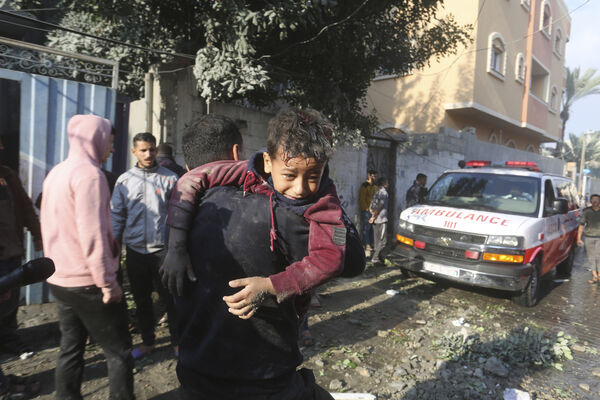
“You see the trauma in children’s eyes, both their own fear but also of course, as they start to look at their parents’ eyes as they did this morning, and realise that their mum and dad have that look that they can’t protect me,” Elder explained.
“The wounds of war on children are probably something I’ve not seen with this intensity before.”
Those wounds had been opened long before the latest bombardment.
In Gaza, teenagers have endured many strikes since Israel imposed a blockade on the strip in 2007.
A child born in Gaza that year survived a first assault aged just two when Israeli forces killed 1,385 Palestinians, including 318 children during 22 days of conflict.
As that child reached primary school in 2012, another eight-day attack took the lives of 168 people in Gaza including 33 children.
Aged seven, that same child witnessed a third round of grief; this time fifty days of fighting resulted in 2,251 Palestinian deaths, among those were 556 children.
In May of 2021, that child, now a teenager, survived once again another bout of war that claimed 256 lives.
But the latest assault has been by far the most deadly. Before the resumption of airstrikes on Friday morning, more than 14,800 Palestinian lives had been taken, including 6,150 children.
Out of this conflict has emerged the chilling acronym WCNSF: Wounded child no surviving family.
Children are resilient, but that resilience has a limit.
“I have been going to Nasser Hospital all week to listen to children, courageous tireless Palestinian health workers, families — to play with children, gently seek to give them a distraction from their nightmare,” said Elder.
At times, I could see a gentle change in their faces. A glimpse of childhood returning. No longer. Fear has returned. So have the wounded. Bloodied bodies were rushed in as I was there.”
How can we do this to our children?
In homes across this country, bedsheets are being altered into angel costumes and tinsel manipulated into halos as children learn the words of Away in a Manger.
‘Bless all the dear children In Thy tender care’.
In Gaza, Shima and Omar are less than 100km away from where Christians say the original Christmas miracle took place in a stable in Bethlehem.

